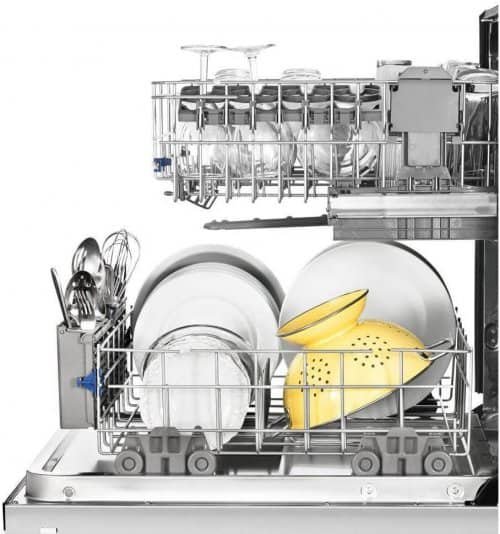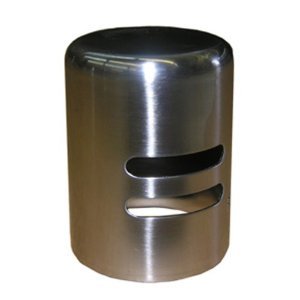Assuming your plumber has let you know that you must install an air gap close to your new dishwasher, you might be wondering why.
What exactly is that little fixture that sticks up over your countertop, and do you truly require an air gap to protect your dishwasher from further damage?
In all actuality, an air gap is the best method to protect your dishwasher from flooding with wastewater. Stopped-up sinks and clogged tubing can send dirty water from the channel once more into your dishwasher.
Many pipe codes really do order dishwashers to drain through an air gap fitting. In any case, an air gap isn’t simply a code-consistent irritation, it is a brilliant method for protecting your dishwasher from any backflow.

Table of Contents
What is a Dishwasher Air Gap?
A dishwasher air gap is a fitting mounted around two creeps over the sink that keeps debased water from reappearing the dishwasher from the drain by means of backflow. An air gap is an easy method for making specific wastewater and impurities never re-enter your perfect water supply.
At the point when you are running your dishes through a wash cycle, the last thing you need is for them to arise streaked with grime pumped in from your clogged waste disposal.
Air gaps are altogether different from the hose running dirty water from the hose racing to the drain.
Since these two ways never meet, there is no issue of wastewater crawling again into your perfect tool.
The space between your kitchen faucet and the edge of your kitchen sink is an ideal demonstration of an air gap. Assuming your waste disposal is clogged and your sink spills over with disgusting water, the water will gush out over the edge of the sink and onto the counter.
There is sufficient distance between the mouth of the faucet and the sink to guarantee that dirty water will not ever discharge into your kitchen faucet and contaminate the spotless water supply. This gap of air safeguards the consumable water from contamination.
How Does Backflow Function?
Backflow is the undesirable reversal of water flow, guiding the polluted water and foreign substances back into the clean water supply.
Dishwasher air gaps are a type of backflow prevention. In plumbing, where wastewater might actually contaminate consumable water is known as a cross-connection.
Cross-connections can prompt backflow when there is an alteration in pressure. For instance, when a sink drain becomes clogged, the hose prompting the drain will begin to pump the wastewater back into the machines. Without an air gap (or a different method for backflow prevention) your dishwasher will flood with polluted water.
How Does a Dishwasher Air Gap Work?
A dishwasher air gap isolates two parts of the hose with an actual gap of air to ensure that cross-contamination between the dishwasher and drain is inconceivable.
One part of the air gap fitting interfaces from the dishwasher to the air gap. The other branch slides from the air gap to the waste disposal.
The hose running the dirty water from the dishwasher leaves the dishwasher and bends up. At its pinnacle, the branch closes and the water spills out of the open mouth of the tube, through the air gap, and down into the next branch. The subsequent branch conveys the wastewater down toward the assigned drainage site.
The two parts of the air gap are installed underneath your sink or countertop. Air gap fittings have an improving heading that stretches out over the counter, for the most part, close to your faucet or soap gadget. This heading houses the upward air gap.
Air gaps are indented with openings that will deliver water into your sink assuming the drain becomes clogged or the tubing is hindered. An air gap spill is an indication that your drainage tubes are clogged and should be wiped out.
What is a Dual Air Gap?
Dual air gaps permit you to run two dishwashers to one drain line through a single air gap or drain both a dishwasher and a water filtration system simultaneously.
A few dishwashers require separate drain lines from the top and bottom compartments of the machine, the two of which can be gone through one dual air gap.
On the off chance that you have a reverse osmosis system under your counter, you can run the wastewater created by the system (known as brackish water) to a similar drainage site as your sink and dishwasher without stressing over cross-debasing some other machine.
Dual air gaps are a versatile technology on the standard air gap allowing you to work on your under-sink plumbing set-up.
Do I Need a Dishwasher Air Gap?
Air gaps are the best method for preventing your drain from cross-sullying your dishwasher with waste. To safeguard your dishwasher from flooding with debased water, you want an air gap.
Dishwasher air gaps are likewise expected by plumbing codes in numerous locations. While air gaps are by all accounts not the only strategy for preventing your dishwasher from backflow, they are the main technique that is demonstrated to work under each situation.
Air gaps have no moving parts, so they cannot fizzle. They work on the principles of basic physical science. Water cannot direct back through an unpressurized gap of air.
Assuming that the drain tube becomes clogged the release water from the dishwasher will basically pour out of the openings on the air gap’s heading.
While other backflow prevention procedures can deter cross-contamination, just an air gap ensures this protection.
The dependability of air gaps is the reason many pipe codes across the United States require all dishwasher installations to incorporate an air gap. Most pipe codes specify that all business food and refreshment preparation sinks should have an air gap.
States including California, Washington, Minnesota, and Hawaii have all embraced a dishwasher air gap installation as a required private pipes technique. In these pieces of the nation, air gaps are surely important.
A plumber installing another dishwasher will expect you to have an air gap connection. In the event that you truly do without an air gap, your house will not depend on code. On the off chance that you were to at any point endeavor to sell your house, the overseer would expect you to install an air gap.
How To Install a Dishwasher Air Gap

Installing an air gap is a basic endeavor that a mortgage holder can undoubtedly manage without the help of a handyman.
Step 1:
Find the air gap opening on your counter. Many counters will have a precut opening currently present on their counter. In the event that this opening isn’t as of now housing an air gap, it is most likely covered by a level plate molded cover.
Eliminate this circle and set it aside. In the event that you don’t have an air gap opening on your counter, you need to drill one yourself. Drill a 1-3/8″ opening in the countertop using an electric drill and opening saw.
Be certain the opening is near the edge of the sink so the air gap will have more than adequate space to drain in the event the tubes flood. You don’t need an air gap flooding your counter.
Prior to boring, tape off the section around the opening with masking tape to safeguard your counter from scratches. On the off chance that your countertop is rock or marble, this errand will be more troublesome, and you might think about getting professional assistance.
Step 2:
Connect the air gap to the dishwasher drain hose. The dishwasher drain hose connects with the smaller leg of the air gap. Join the 5/8″ tube to the 5/8″ leg of the air gap. Using stainless steel hose clips, secure the tube firmly to the air gap.
Step 3:
Connect the air gap to the drain hose or waste disposal. Measure and cut a length of 7/8″ tubing to interface the air gap to either your drain or your waste disposal. Secure the tube to the air gap with a hose cinch.
On the off chance that you are running the air gap straightforwardly to the drain, join the tube to the Y-branch rear end interface the sink to the drain, and secure the tubing with a hose clip.
Ensure your Y-branch rear end is viable with 7/8″ tubing. On the off chance that you are connecting the air gap to waste disposal, find the tube jutting from the side of the waste disposal unit.
On the off chance that an air gap has not recently been installed on this removal, you should eliminate the metal attachment inside the tube. This permits removals to be viable with both air-gap and non-air-gap setups.
Check to guarantee there are no wrinkles in the tubing and connect the 7/8″ tubing to the removal and secure it with a hose cinch.
Step 4:
Push the air gap up through the opening on the counter. Eliminate the vanity covering on the air gap heading and supplement it through the opening in the counter from beneath.
Fix the air gap against the counter by stringing the nut along the air gap’s strings. You might need to have a connection to hold the air gap set up to prevent it from turning as you install it.
When the nut is strung on manually and the air gap is balanced out, use a wrench to ensure the air gap is safely secured to the counter. Put the vanity cover back on the air gap.
Step 5:
Run your dishwasher on a fill cycle. Check the air gap and tubing connections for any indications of spilling. Ensure there’s no water getting away from the waste disposal or air gap and trickling into your cabinet.

Can I at Any Point Install an Air Gap Under The Counter?
There is no endorsed air gap that can be installed together underneath the counter. The air gap should be installed at a higher elevation than the dishwasher for it to accurately function. A dishwasher air gap should stretch out over the countertop and drain into the sink.
An air gap installed under the counter could flood your under-sink area. Assuming that the drain was to become clogged, water would spill over out of the air gap and into the cupboard, harming the planks of flooring.
A few homeowners object to air gaps because they view the fixture as unattractive in their kitchen. There are a few imaginative options accessible to those wishing to conceal their air gaps, for example, a cross-breed air gap soap dispenser.
These disguise the air gap inside a functional hand soap dispenser, making the air gap heading less obvious on your counter.
What states require a dishwasher air gap?
Different states have different requirements. However, a quick Google search suggests that dishwasher air gaps are required in California, Colorado, Florida, Georgia, Illinois, Indiana, Louisiana, Massachusetts, Michigan, Minnesota, Nevada, New Jersey, New York, North Carolina, Ohio, Oklahoma, Pennsylvania, Rhode Island, South Carolina, Tennessee, Texas, Virginia, and Wisconsin.
How to hide a dishwasher air gap?
There are a few ways to hide a dishwasher air gap. One way is to use a decorative cover. Another way is to install the air gap under the sink.
Is a dishwasher air gap necessary?
A dishwasher air gap is not necessary, but it can be helpful in preventing dirty water from backing up into your dishwasher.
How to install dishwasher air gap under countertop?
To install a dishwasher air gap under a countertop, first remove the old air gap. Then, measure the space between the dishwasher and the countertop. Cut a hole in the countertop using a hole saw that is slightly larger than the space between the dishwasher and the countertop. Install the new air gap by inserting it into the hole in the countertop and screwing it into place.
With that, we have now come to an end to our guide on air gap with regards to dishwashers. We hope it helps you in learning everything you need to learn.


17 thoughts on “What is a Dishwasher Air Gap”
Comments are closed.